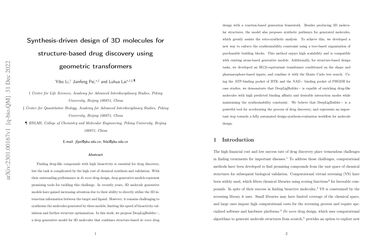Synthesis-driven design of 3D molecules for structure-based drug discovery using geometric transformers
Finding drug-like compounds with high bioactivity is essential for drug discovery, but the task is complicated by the high cost of chemical synthesis and validation. With their outstanding performance in de novo drug design, deep generative models represent promising tools for tackling this challenge. In recently years, 3D molecule generative models have gained increasing attention due to their ability to directly utilize the 3D interaction information between the target and ligand. However, it remains challenging to synthesize the molecules generated by these models, limiting the speed of bioactivity validation and further structure optimization. In this work, we propose DeepLigBuilder+, a deep generative model for 3D molecules that combines structure-based de novo drug design with a reaction-based generation framework. Besides producing 3D molecular structures, the model also proposes synthetic pathways for generated molecules, which greatly assists the retro-synthetic analysis. To achieve this, we developed a new way to enforce the synthesizability constraint using a tree-based organization of purchasable building blocks. This method enjoys high scalability and is compatible with existing atom-based generative models. Additionally, for structure-based design tasks, we developed an SE(3)-equivariant transformer conditioned on the shape and pharmacophore-based inputs, and combine it with the Monte Carlo tree search. Using the ATP-binding pocket of BTK and the NAD+ binding pocket of PHGDH for case studies, we demonstrate that DeepLigBuilder+ is capable of enriching drug-like molecules with high predicted binding affinity and desirable interaction modes while maintaining the synthesizability constraint. We believe that DeepLigBuilder+ is a powerful tool for accelerating the process of drug discovery.
PDF Abstract
